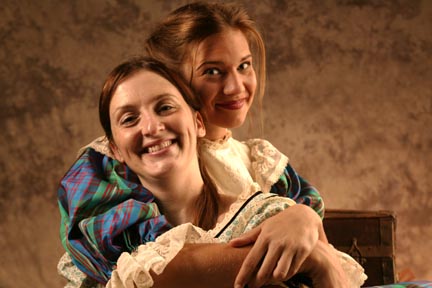
KUMU KAHUA THEATRE
Actresses Jennifer Robideau, right, and Laura Bach play Fanny and Belle, respectively, in Kumu Kahua Theatre's production of Victoria Kneubuhl's "Fanny and Belle: The Story of Mrs. Robert Louis Stevenson and Her Daughter Belle Osbourne."
Play is surprisingly
entertaining
The title characters in Kumu Kahua Theatre's "Fanny and Belle" are the wife and stepdaughter of famed 19th-century author Robert Louis Stevenson, but playwright Victoria Nalani Kneubuhl's exploration of their relationship as mother and daughter makes the production more than a period piece about two long-dead women. Jennifer Robideau (Fanny) and Laura Bach (Belle) are well cast in the title roles, and their performances invite us to consider the nature of our own parent-child relationships.
"Fanny and Belle"
Presented at Kumu Kahua Theatre, 26 Merchant St.
When: Runs 8 p.m. Thursdays to Saturdays and 4 p.m. Sundays through April 10
Tickets: $13 Thursdays only (discounts for seniors, students and the unemployed), $16 for all other performances (discounts for seniors, students and groups of 10 or more)
Call: 536-4441
The story begins and ends in Samoa. The year is 1915. Fanny has died, and Belle has brought her ashes back to Samoa for burial next to Stevenson on Mount Vaea. Everything else takes place in Belle's memory as she recalls the arc of her mother's eventful life, as well as her own.
Fanny was raised in the American Midwest by a warm and loving father and a cold and demanding mother. She married handsome Sam Osbourne but discovered he was a chronically unfaithful man. Fanny left him, took their three children to Europe so she could study art and became romantically involved with Stevenson. She decided to give her marriage a second try only to find Sam hadn't changed, so she divorced him and married Stevenson despite the fact that he was 10 years younger, almost penniless and faced the prospect of being cut off by his family if he married her, an older divorcee.
Fanny eventually won over her in-laws. Stevenson eventually became famous.
Belle grows up in her mother's shadow and makes some of the same choices. She marries handsome Joe Strong, a promising artist who turns out to be as unfaithful to her as her father was to her mother. Many years later, she, too, finds love in the arms of a younger man.
While Kneubuhl never stints in providing the historical context of the women's lives and the importance of Stevenson as the foundation of the family during the 14 years he and Fanny were together, she also shows the relationship between mother and daughter evolving through the years and through their shared experiences.
Fanny stepped in to short-circuit young Belle's potentially unwise relationship with an Irish artist while they were in Europe, but was unable to prevent her daughter's marriage. In some scenes we see them as allies; in others, as competitors or rivals. It is not until after her mother's death that Belle resolves her feelings.
DIRECTOR John Wat paces the action so that the narrative remains interesting and the action lively even though we know how the story ends. Angela Price (set design) provides an interesting multilevel performance area with a large central stage and three elevated satellite stages. Keith Kashiwada (sound design) adds essential ambience to several scenes.
An ensemble cast of eight plays 47 secondary characters between them:
» James Rudy sounds a bit like Mr. Scott, of "Star Trek," but keeps his accent intact while playing Stevenson as a complex, compassionate and honorable man, despite his lifelong fragile physical condition. Rudy looks the part of a frail but passionate writer. A large and reasonably realistic-looking mustache ages him enough to make him also look right as Robideau's leading man.
» Eric Schonleber fits easily into two key secondary roles. He appears first as Sam Osbourne, a caddish husband to Fanny but nonetheless a loving and nurturing father to Belle. He also portrays Lloyd, the son of Sam and Fanny, who as an adult was the one who managed the finances of his stepfather's Samoan estate.
» John Watson portrays the equally caddish Joe Strong and returns late in the story as a young man whose initial interest in Belle is overshadowed by his fascination with her famous mother.
Michelle Crush, Victoria Gail-White, Wil Kahele, Terri Seeborg and Laurie Tanoura are the other ensemble members.
The one downer in the story is our knowledge that Stevenson will die in 1894. He is such an important part of the story that most of the action takes place before then.
Fanny lived another 20 years. She continued to be unconventional and refused to accept the limitations that American women were expected to abide by, although she apparently never understood why Belle thought women should be allowed to vote. Belle found a separate identity as a suffragette but still found herself feeling that she was in competition with her mother.
Perhaps it is because the story is told in retrospect, but the age of the cast members doesn't intrude on their performances even though Bach is older than Robideau, and both women appear to be older than Rudy, Schonleber and Watson. Everything fits together, the ensemble is a solid unit and "Fanny and Belle" becomes a surprisingly entertaining look at the lives and times of three interesting people from the 19th century whose experiences might be closer to our own than expected.
Click for online
calendars and events.

